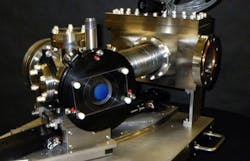McPherson unveils high-energy XUV spectrometer that measures from 300 to 1 nm wavelengths
McPherson (Chelmsford, MA) has announced a grazing-incidence wavelength-dispersive extreme-UV (XUV) optical spectrometer (called the model 248/310) that allows rapid analysis of spectral light at wavelengths from 300 nm all the way down to ~1 nm (4 to 1200 eV). In addition to high-harmonic laser generation experiments, the spectrometer, which has a Rowland-circle design, is useful for measuring ion- or discharge light sources, calibrating astrophysics detectors, and other uses. For example, at FLASH, the world's first soft x-ray free electron laser, which is located at Deutsches Elektronen-Synchrotron (DESY) in Hamburg, Germany, the McPherson 248/310 UHV spectrometer has assisted in analysis of the 2.3 to 4.4 nm water window (a region transparent to light).
At the Laboratory of Radiation Physics at Belgorod State University in Russia, the same model of spectrometer is being used to investigate the interaction of x-rays and fast electrons with condensed media by measuring the Cerenkov effect (in which subatomic particles traveling faster than the speed of light in a local medium produce radiation).
McPherson notes that experimental fusion reactors around the world also use the company's XUV spectrometers. McPherson also says that, when configured in reverse, the 248/310 instrument operates as a tunable light source that is useful for spectral calibration and spectroscopy in the vacuum ultraviolet (VUV), extreme UV (EUV, and soft x-ray (SXR) wavelength regions. Light is detected via direct detection CCDs, image intensifiers, microchannel plates, or electron multipliers.
The Model 248/310 ships assembled and tested for spectral resolution and with vacuum leak test certification. Adapters, differential pumping, and grazing incidence collection optics to more easily connect to the experiment can be included also. Every shipment is complete with a wavelength calibration certification, says McPherson.
For more info, see www.mcphersoninc.com.
Source: McPherson
